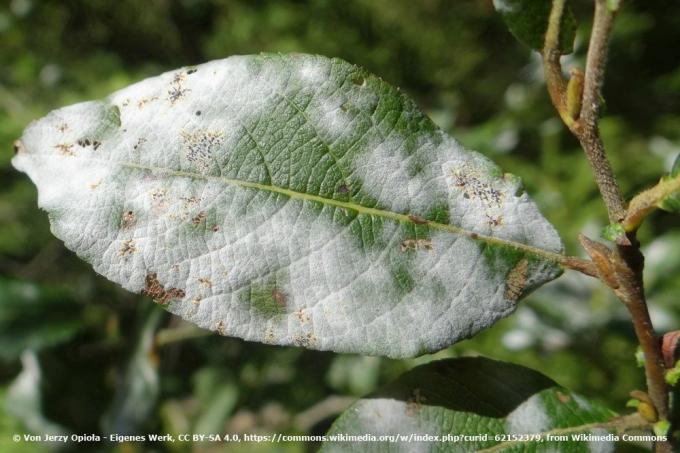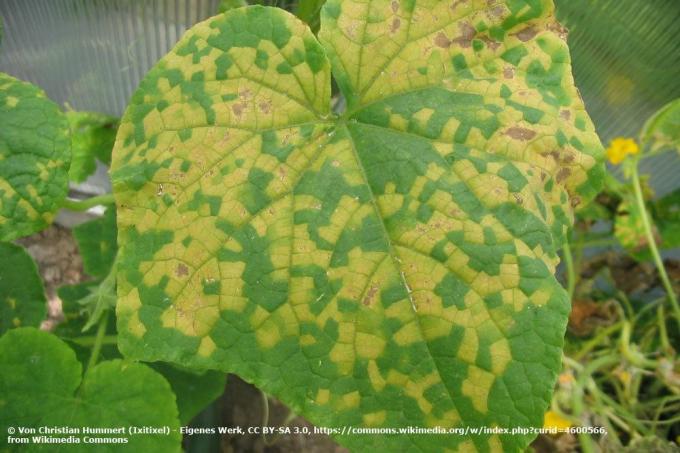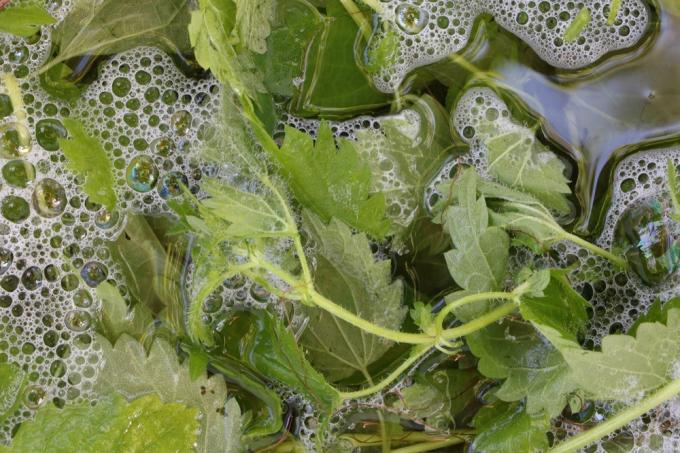
table of contents
- Causes of white spots on the leaves
- Powdery mildew
- Symptoms
- Control measures
- Prophylactic measures
- Spider mites
- Leaf hoppers
- Care errors
Herbs come in a great variety. They are very popular as a condiment, decoration of food and for the relief of diseases. No wonder that the trend is towards growing herbs in your own garden. There is a place everywhere. Sage, thyme, peppermint and the like do not require much space and are very frugal in their care. They even thrive in the tub on the balcony. Occasionally, however, it can happen that white spots appear on the herbs. It is then important to act as quickly as possible to prevent it from spreading.
Causes of white spots on the leaves
If the leaves of herbs turn white, the cause must be investigated as quickly as possible in order to take appropriate measures to prevent them from spreading. In the worst case, the plants can die. Causes for this can be:
- mildew
- Spider mites
- Leaf hoppers
- Care errors
Powdery mildew
Powdery mildew is caused by a fungus and is also known as "fair weather fungus" because the Fungal spores multiply and particularly quickly in dry, warm weather and nocturnal dew formation spread. The mushrooms love temperatures around
20 ° C and a humidity of 70 percent. The powdery mildew fungus belongs to the hose fungi. It penetrates the outer cell layer of the leaves, stems and flowers. Nutrients and water are withdrawn from the host plant. Mainly peppermint, parsley, lemon balm, oregano, rosemary, Borage and sage infested with powdery mildew.

Symptoms
- Dry plants most often affected
- Mainly occurring in the months of May to August
- Velvety white-gray coating on the upper side of the leaf
- At first only small white, floury spots visible on the leaf
- The entire leaf is increasingly attacked
- The deposit can be wiped away with your fingers
- In the advanced stage, discoloration of the covering is dirty brown
- Leaves eventually dry up
- If the infestation is severe, the plant dies
Powdery mildew is not allowed with the Downy mildew be confused. This is also known as the "bad weather mushroom" because it loves moisture. He is recognizable
- on the infestation on both leaf sides
- white coating on the underside of the leaf
- Lightening or yellow spots visible on the upper side of the leaf

Control measures
When the first signs of stains appear, action is required. Prompt treatment of the affected plants can prevent the disease from spreading. Most of all is important
- Remove infected leaves
- Dispose of in household waste or burn, not on the compost
Before resorting to the chemical club, biological measures should first be used. Here are some home remedies that will be helpful in fighting powdery mildew.
- Treatment with milk, mix fresh milk with water in a ratio of 1: 8, spray the plant every few days
- Spray with garlic tea, pour ½ l of boiling water over 2 thick cloves and allow to cool
- Spray with broth made from 3 packets of baking powder, 50 ml rapeseed oil, 5 l lukewarm water, a few drops of dishwashing detergent every 10 to 14 days, 5 to 8 applications are sufficient
- Use of nettle, tansy or horsetail broth
- Use of ladybirds and sawflys
- In very acute cases, radical pruning is necessary
If nothing helps, chemical agents can be used to combat powdery mildew. Among other things, Compo Bio Mildew-Free Thiovit Jet can be used. The treatments are carried out 8 to 12 days apart.

tip: Horsetail broth contains silicic acid and strengthens the leaf surface. To make it, 300 g of fresh or 30 g of dried field horsetail are soaked in 10 liters of water for 24 hours. Then heated and boiled for 15 minutes. When cooled, it is diluted with water in a ratio of 1: 5.
Prophylactic measures
- Choose sufficient spacing between plants so that leaves can dry off after rain
- No waterlogging, but permeable soil necessary
- Only water when the soil surface is dry
- Do not wet the leaves, always water from below, morning and evening
- Regularly removing weeds can be vectors
- Trimming shoot tips in autumn provide good hiding places for powdery mildew fungus
- No over-fertilization, especially be careful with nitrogen
- Choose resistant varieties
- Plant strengthening with horsetail broth
- Spray with 20 ml fennel oil, 7.5 ml soy lecithin and 5 l water
tip: Plant garlic, chives or chervil between the individual herbs. These help contain powdery mildew.
Spider mites
The small teats can hardly be seen with the naked eye. Because they are only up to 0.8 mm in size. Spider mites are located on the underside of the leaves, sting them and sucking out the sap. The spread occurs mainly in dry, warm weather. Oregano is very often attacked. Spider mites can be recognized by the following symptoms:
- Small, white speckles on the upper side of the leaf
- Filaments between the plant parts
- Web can cover entire plants
- Leaves dry out if the infestation is severe

Fight spider mites
The small suckers are usually easy to fight if the causes of the infestation are eliminated. Because spider mites don't like moisture. Now there are different ways to kill the pests:
- Increase the humidity by ventilating the greenhouse well
- In the field, mulch to ensure even moisture
- Water thoroughly on hot days
- Rinse off infected plants with a strong jet of water, especially the underside of the leaves
- Sprayings with a brew of nettles, field horsetail or wormwood
- Fertilization with cigarette ash
- Spray with 500 ml of water and 15 ml of dissolved potassium soap, moisten the infected leaves with it for 15 minutes
- As a preventive measure, pour an onion stock as a cold water extract from onion and garlic peels at intervals
- Prophylactic use of a brew made from pressed seeds of the Indian niece tree
When using chemical pesticides, the plants can quickly become resistant. Repeated treatment with acaricides is then always necessary.
Leaf hoppers
The leaf cicadas belong to the constant winged species. There are 45,000 species worldwide. In warm areas they make humming noises, but the animals are known as pests in Germany. The cicada reaches a size of 2.6 to 3.3 mm and is yellow-green in color. The head has three black spots and two on top of the forehead.
Leaf hoppers mainly attack sage, thyme, basil, Lemon balm, marjoram, but also other herbs, especially perennial cultures.

Symptoms
- White to silvery speckles over the entire leaf, transmission of fungal spores possible
- The leaves later turn brown and eventually die off
- Cicadas visible in sunshine and warm weather
- If the infestation is severe, the plant dies
Direct combat
Fighting leaf hoppers is quite difficult. The following measures can be helpful:
- If there is no wind, spray the underside of the leaf with very diluted vinegar essence in the early morning hours
- Installation of yellow boards or yellow stickers
- Injection with a solution of 5 ml neem oil, 1.5 ml Rimulgan and 1 l water
- To treat the larvae, use universal insecticides such as Neem Azal T / S
Preventive measures
It does not always have to lead to an infestation with cicadas, then preventive action is necessary. Herbs can be protected from the constant winged animals with simple means:
- Setting up yellow boards
- Cover the plants with insect protection nets
- Powder the herbs with rock flour in spring and late autumn
- Keep a distance to infested plants when replanting
Care errors
Occasionally, incorrect care for herbs can result in a white discoloration of the leaves. It is therefore important to give the plants proper care from the outset. It starts with the choice of location. Furthermore, the following must be observed:
- Sunny location, but no direct sunlight, otherwise leaves can get sunburn
- Soil must be permeable, no waterlogging
- Loosen the soil between plants so that air can get to the roots and water and nutrients are better absorbed
- Watering directly in the root area, morning and evening
- Only pour when the surface of the earth is dry
- Do not wet leaves
- Remove weeds regularly
- Regularly break out shoot tips and possibly flower approaches
- Use small amounts of horn meal, liquid organic complete fertilizer or primary rock meal (minerals and trace elements) for fertilization
- Regular top dressing for heavy consumers such as basil, Lovage, Chives and parsley

